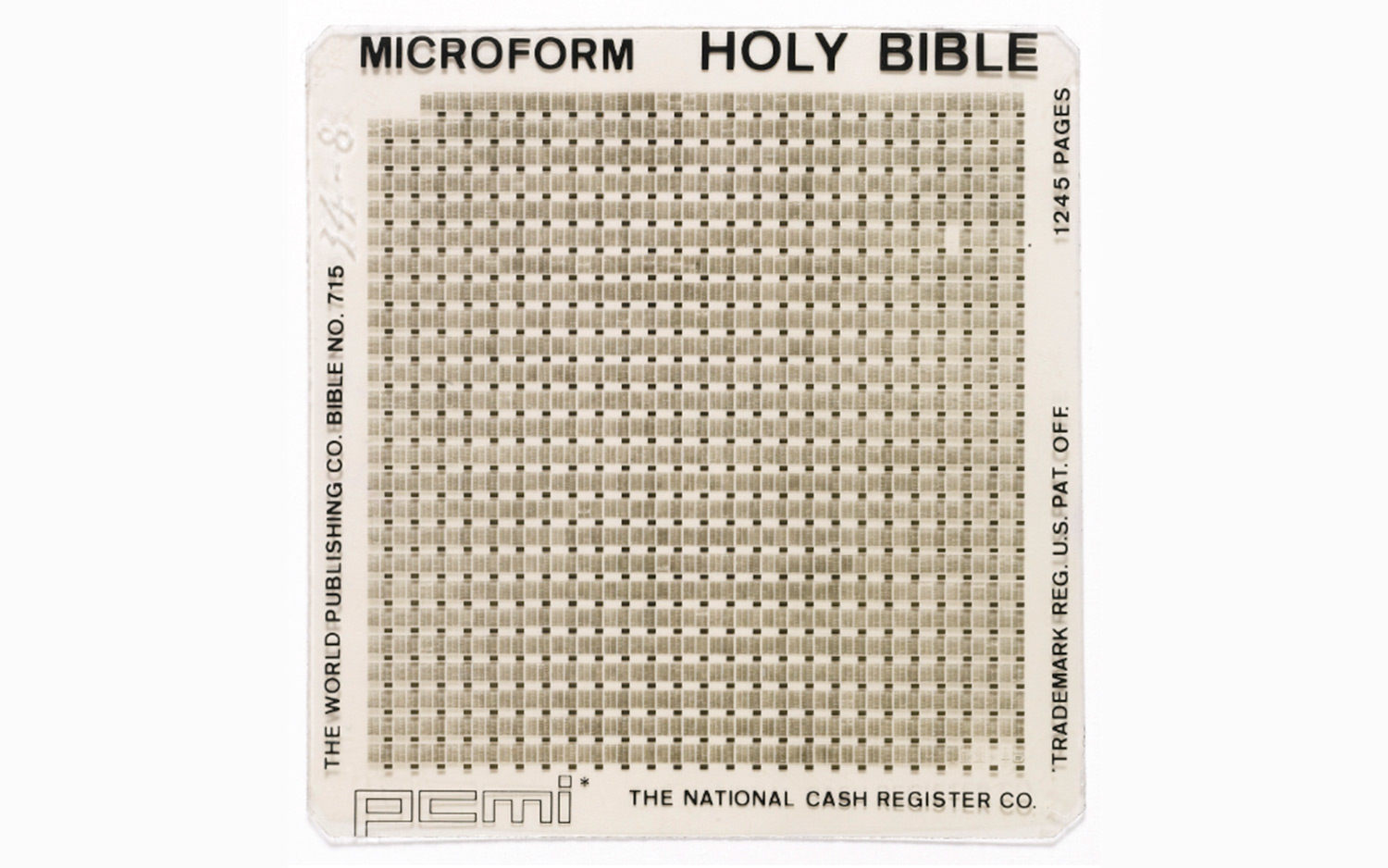Rare 'Lunar Bible' That Visited the Moon Is Up for Auction

How much would you pay for a Bible that flew to the moon?
A rare, miniature Bible that traveled on board NASA's Apollo 14 mission in 1971 is up for auction, with bidding — currently underway — starting at $50,000.
Along with the microform King James Bible, which is mounted and framed in a gold-and-enamel setting, the auction lot includes two certificates of authenticity. One document was signed by Apollo 14 astronaut Edgar Mitchell, verifying that the Bible made a lunar landing; the other was signed by the Rev. John M. Stout, a NASA information scientist and the director of the Apollo Prayer League (APL), which organized the moon visits of this and other lunar Bibles. [Photos: Hidden Text Discovered in England's Oldest Bible]
The tiny Bible didn't take up much room while on board the spacecraft — all 1,245 pages were condensed and printed on a single microfilm square that measures about 1.6 square inches (4.1 square centimeters), according to the item description posted online by Nate D. Sanders Auctions (NSA), which is conducting the auction.
Apollo 14, which landed on the moon on Feb. 5, 1971, was the first mission to successfully transport a Bible to the lunar surface, following two failed attempts during Apollo 12 and Apollo 13, according to the APL website. The lunar Bible initiative was launched by the APL, an organization founded in 1968 by pastors working within NASA "to pray for the safety of the astronauts and the skill of NASA employees who built the rockets they would fly," according to the APL mission statement.
"And — most importantly — to land a Bible on the moon," the statement concluded.

APL's efforts commemorate Apollo 1 astronaut Edward White, who wanted to bring a Bible to the moon but never made it there. White died when a fire ignited during a launch rehearsal on Jan. 27, 1967; the blaze also claimed the lives of two other astronauts, Virgil "Gus" Grissom and Roger Chaffee, NASA wrote in a mission summary.
Sign up for the Live Science daily newsletter now
Get the world’s most fascinating discoveries delivered straight to your inbox.
Hundreds of these so-called lunar Bibles were bundled in packets and carried by Apollo 14 to the moon. The lunar module held 100 copies, and 200 copies were stowed in the command module, Space.com reported. According to the APL, an additional 212 microfilm Bibles were stowed onboard in a small bag reserved for astronauts' personal items; these bags were known as personal preference kits (PPK). Though NASA could only confirm the presence of 300 microfilm Bibles on the Apollo 14 mission, it was not unusual for small, undocumented items to travel to space as part of an astronaut's collection of personal effects, Elizabeth Suckow, an archivist with NASA's History Division, told Live Science in an email.
"Such informal stowage to take items into space (often U.S. currency, such as Mercury dimes, or handmade signs) took place on nearly every mission from Mercury through Apollo," Suckow said.
"Unless the item was found or used by astronauts in flight, it remained undocumented and was removed when the spacecraft returned to Houston," she explained.
In 1971, Mitchell carried 100 Bibles to the moon's surface. Only 11 copies of the Apollo 14 lunar Bibles bear letters of authenticity signed by both Mitchell and Stout, and of those, seven copies remain in circulation, NSA representatives wrote in the catalog.
After the Apollo 14 mission returned to Earth, Mitchell presented the lunar Bibles to Stout, Space.com previously reported. Stout kept some of the Bibles and distributed copies among APL members; decades later, a six-year legal battle concerning several of those Bibles was launched after a state agency questioned a private owner's claim to the artifacts, according to Space.com. (The suit was eventually dropped in May 2017.)
Not all of the spacebound Bibles made it back to Earth. One paper copy of a Bible with a red cover — brought to the moon on the Apollo 15 mission — still rests on an abandoned Lunar Roving Vehicle dashboard, left by astronaut David Scott, Suckow told Live Science.
Bids for this Bible can be submitted online, and the auction concludes on July 26 at 2 p.m. EDT.
Editor's Note: This story was corrected on July 25 to note that the number of Bibles carried by Apollo 14 (according to NASA records) was 300, not 512. It was further amended on Aug. 14 to identify David Scott (not James Irwin as was previously stated) as the Apollo 15 astronaut who left behind a Bible on the moon.
Original article on Live Science.

Mindy Weisberger is an editor at Scholastic and a former Live Science channel editor and senior writer. She has reported on general science, covering climate change, paleontology, biology and space. Mindy studied film at Columbia University; prior to Live Science she produced, wrote and directed media for the American Museum of Natural History in New York City. Her videos about dinosaurs, astrophysics, biodiversity and evolution appear in museums and science centers worldwide, earning awards such as the CINE Golden Eagle and the Communicator Award of Excellence. Her writing has also appeared in Scientific American, The Washington Post and How It Works Magazine. Her book "Rise of the Zombie Bugs: The Surprising Science of Parasitic Mind Control" will be published in spring 2025 by Johns Hopkins University Press.









